Extraordinary Way To Use Your Mind Efficiently In contemporary times, there is a prevalent inclination towards digital writing methods due to advancements in technology, leading to a reluctance to engage in traditional pen-and-paper writing practices. However, it is widely acknowledged that manual writing, facilitated by hand, fosters enhanced memory retention.
This sentiment is often echoed by mentors who advise individuals to reinforce their memory by repetitively transcribing information. Scientists are increasingly corroborating this notion, emphasizing the importance of manual writing in cognitive development. Therefore, it is recommended that individuals, particularly the youth, prioritize the cultivation of manual writing skills over sole reliance on digital technologies for written communication and learning purposes.
In a recent study, it was uncovered that individuals who engage in handwriting exhibit heightened electrical activity spanning various interconnected brain regions associated with motor skills, visual perception, sensory processing, and memory retention. This underscores the importance of parental guidance in fostering handwriting skills and facilitating optimal learning experiences for children.
Numerous researchers are dedicating significant efforts to elucidate the mechanisms through which handwriting contributes to enhanced brain functionality, both in young individuals and adults. Moreover, a study elucidated that when information is typed on a computer, it tends to be processed in a superficial manner, primarily involving auditory input and motor output, without robust engagement of cognitive processing pathways.
Indeed, when individuals engage in manual writing, they typically undergo a sequence of cognitive processes. Initially, they attentively listen to the information, followed by its meticulous processing, prioritization, consolidation, and integration with pre-existing knowledge frameworks. In a research context, electrodes were intricately integrated into a hairnet featuring 256 sensors, enabling the comprehensive recording of brain activity among 36 students. These individuals were tasked with either handwritten or typed transcription of 15 words extracted from the game Pictionary, which were presented visually on a screen.
Furthermore, the study highlights that when students or young children engage in manual writing, the sensors detected extensive connectivity across numerous brain regions. Conversely, typing elicited minimal, if any, activity in these same areas. This disparity in neural activation underscores a fundamental distinction in the cognitive processes underlying the two modalities. Specifically, typing involves a repetitive and uniform movement of the fingers to produce each letter, whereas manual writing provides a multisensory experience characterized by tactile feedback and proprioceptive sensations, contributing to a more robust cognitive engagement.
It is recommended that every young individual enhance their memory capacity by adhering to the practice of manual writing and learning. This approach stimulates comprehensive brain engagement, thereby optimizing cognitive function and enabling individuals to harness their cognitive faculties to their fullest potential.















